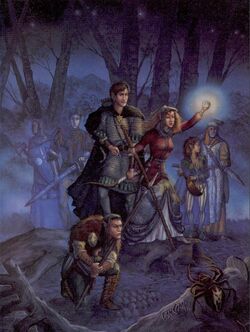Naralis Analor (sometimes seen as Naris Analor) was the lesser elven deity with the seemingly paradoxical portfolio of suffering, alleviation of pain, healing, and death. Unlike many gods of death, however, the Watcher of Souls was neither malicious nor apathetic towards his charges, living or dead.[4][5]
Description[]
Naralis appeared as a male elf about 6 feet (1.8 meters) tall with blue-gray eyes and silver hair. He usually wore a robe of white and gray with a silver trim or design.[5]
Personality[]
Naralis's primary interests were two-fold; he sought to safeguard the souls of the elven dead and, knowing full well that every living elf would die and eventually pass into his care, heal elves while they were still alive.[4]
Powers[]
Naralis was immune to death magic, baneful necromantic spells , and psionics, and could not be harmed by anything less than +3 enchanted weapons.[5]
Possessions[]

The holy symbol of Naralis.
On his left hand, Naralis wore an iron ring set with a black jewel that could cast harm once every minute within 540 feet (160 meters). On his right hand, he wore a mithril ring set with a clear, glowing jewel that functioned the same but could cast heal instead. In battle, he carried a +4 longsword that had a special draining ability against evil beings that had baselessly harmed a good or neutral elf within the past year.[5]
Realm[]
Naralis conducted his divine duties in his realm known as Healing Glade.[4][note 1]
Activities[]
As a god of death, Naralis ensured that the souls of the elven departed reached their proper afterlife.[4] Very rarely (for about one out of every hundred requests), he responded to petitions by dying elves for a heal spell, but he would only do this once in an elf's life and within the next two weeks compel them (through an insurmountable geas spell) to complete some task for him appropriate to their capabilities.[5]
Relationships[]
Naralis served Sehanine Moonbow, elven goddess of the moon, in the process of elven death, taking newly deceased souls from her care and guiding them to their new existence.[4] Due to their closely related spheres of influence, he often worked with and consulted with Labelas Enoreth, the elven god of longevity.[5] Outside of the Seldarine, Naralis was allied with Ilmater and Kelemvor, Faerûnian gods of perseverance and death respectively, and opposed Loviatar and Null, the Faerûnian goddess of pain and draconic god of death.[4]
Worshipers[]

A priest of Naralis (far right).
Naralis was very popular in worlds where he was worshiped, his faithful being those non-evil elves concerned with keeping their fellows healthy and providing hospice for those that would die. His clergy was about 60% clerics and 40% specialty priests known as Heralars, and the groups worked together in harmony. They conducted funerary ceremonies and tended to the sick and dying.[4]
Naralis was worshiped within the deep forests, and his holy days were during the new moon, whereupon the clergy would wear white cowls and gray-white robes. During their monthly services, prayers were made and crafted items sacrificed to the Healer, which were left with the bodies of the deceased in the case of funerals, whether in a vault or grave.[4]
Though elves did not exactly fear death, his worshipers were often adventurers who would pray to him and give him their respects in the hopes he would have death pass them by. Friends and relatives of a deceased elf usually prayed for him to speed the soul of the departed to its resting place.[5]
Notable Worshipers[]

Kwellythe.
- Kwellythe: A delusional and eccentric elven worshiper of Naralis who believed the god wanted her at his side and that it was her destiny to join him.[6]
History[]
According to one elven myth, Naralis was one of the original elven gods who Corellon ascended to divinity by giving a unique name.[7]
Sometime around the Second Sundering, Naralis had been a long-forgotten being within the Realms, although his current status remained unclear.[6]
Rumors and Legends[]
It was rumored that Naris's clergy started the elven tradition of planting a tree over a dead elf's body as a way of continuing the circle of life.[4]
Appendix[]
Notes[]
- ↑ 1.0 1.1 Dragon magazine 155 puts Naralis Analor in the plane of Olympus, where most Seldarine reside, instead of Elysium.
References[]
- ↑ Mike Mearls, Jeremy Crawford (May 29, 2018). Mordenkainen's Tome of Foes. Edited by Kim Mohan, Michele Carter. (Wizards of the Coast), p. 43. ISBN 978-0786966240.
- ↑ Mike Mearls, Jeremy Crawford (2014). Player's Handbook 5th edition. (Wizards of the Coast), p. 60. ISBN 978-0-7869-6560-1.
- ↑ Jeremy Crawford, Mike Mearls, Robert J. Schwalb, Adam Lee, Christopher Perkins, Matt Sernett (November 2017). Xanathar's Guide to Everything. Edited by Kim Mohan. (Wizards of the Coast), pp. 19–20. ISBN 978-0-7869-6612-7.
- ↑ 4.0 4.1 4.2 4.3 4.4 4.5 4.6 4.7 4.8 4.9 Chris Perry (December 1996). “The Seldarine Revisited”. In Pierce Watters ed. Dragon #236 (TSR, Inc.), p. 15.
- ↑ 5.0 5.1 5.2 5.3 5.4 5.5 5.6 5.7 Denise Lyn Voskuil (March 1990). “The Elfin Gods”. In Roger E. Moore ed. Dragon #155 (TSR, Inc.), p. 24.
- ↑ 6.0 6.1 Mellanie Black (2020). Tipping the Scales (DDAL09-10) (PDF). D&D Adventurers League: Avernus Rising (Wizards of the Coast), pp. 11, 19–20.
- ↑ Mike Mearls, Jeremy Crawford (May 29, 2018). Mordenkainen's Tome of Foes. Edited by Kim Mohan, Michele Carter. (Wizards of the Coast), p. 36. ISBN 978-0786966240.
